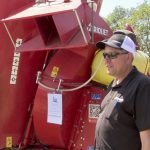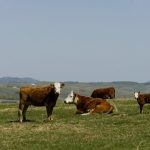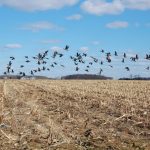
 Livestock
Livestock

Counteracting livestock predation risks on pasture
A three-year study in Manitoba tested several methods of preventing predation of cattle and sheep
Predators such as coyotes, wolves, bears, cougars and foxes have been threatening and killing young, weak and compromised cattle and sheep in Manitoba since domestic farming began. Financial losses range between minimal to potentially devastating depending on location, workforce numbers, operation size and nearby habitat. To counteract and help mitigate these challenges, in 2020 the […] Read more

Feedlot transition takes many steps
Family hopes to make succession process smoother by using a business tool, hiring a facilitator and holding weekly team meetings
Glacier FarmMedia – Les Wall has ownership in three feedlots and a desire to retire, so the Wall family knew they had to get serious about succession planning. The family spent years planning and thinking about the future, and then took a giant step forward by joining EOS Traction, a business tool designed to bring […] Read more

VIDEO: Trioliet feed mixer gets kudos from feedlot operator
Four manufacturers participated in the TMR mixer demonstrations at Ag in Motion this past July (watch our Penta, Jaylor and Highline videos), each looking to gain the attention of livestock producers when it comes to the value feed mixing offers for cattle producers. In our fourth and final video from the show, Ben Meinen talks […] Read more
Tough decisions ensue when rabies infects dairy cow
Veterinary Case Study: A farmer with a rabid cow wonders whether he and his family could be at risk
Jim stopped by the clinic to pick up vaccine, dewormer and meloxicam for processing calves on the weekend. He asked if we could talk privately. We went to my office and closed the door. “I think I have a problem and need your advice,” Jim said. “Just before coming to town, my 15-year-old son came […] Read more

The link between stockmanship and animal health
Lee Sinclair has dedicated much of his professional life to teaching producers about low-stress cattle handling
When Lee Sinclair would come home from college and university in the summers, he worked at feedlots, which is where his interest in low-stress cattle handling started. “Nobody had ever told me position, distance and angles make the difference. All we were taught is, we’ve got to get this done,” Sinclair said. “So you use […] Read more

Researcher examines straw-based cattle diets
Years of drought inspired grad student to look into ways of supplementing straw with flax and canola screenings so producers can retain more cattle during tough times
The latest stretch of drought spurred graduate student Beatriz Montenegro Gonzalez to examine the potential of wheat straw as cattle feed in tough economic times. It was a chilly June day when Gonzalez, along with several other researchers, presented at the Livestock and Forage Centre of Excellence field day near Clavet, Sask. As people filed […] Read more

Beef producers weigh in on weaning, preg checking and more
Research on the Record with Reynold Bergen
Earlier this year we asked you to participate in the industry’s Canadian Cow-Calf Survey. Knowing which production practices producers are adopting in different regions of the country, which they aren’t (and why) helps us target our producer-focused extension efforts better. The official report isn’t out yet, but here’s a sneak peek at some seasonally relevant results. […] Read more

Beef cow, replacement heifer numbers suggest producers aren’t ready to grow herds: FCC
Beef cattle prices have trended above the five-year average, but low numbers of replacement heifers and beef cows suggests producers aren't ready to grow cattle herds.

Klassen: Discounts start to appear in the feeder market
For the week ending September 14, Western Canadian feeder cattle prices were relatively unchanged compared to seven days earlier. However, yearling quality has become quite variable resulting in a diverse price structure.

Hunters urged to take biosecurity measures against bird flu
Farmers who plan to hunt geese and ducks this fall should take biosecurity measures to ensure they don't transmit high path avian influenza (bird flu) to their flocks and herds.


 Livestock
Livestock
